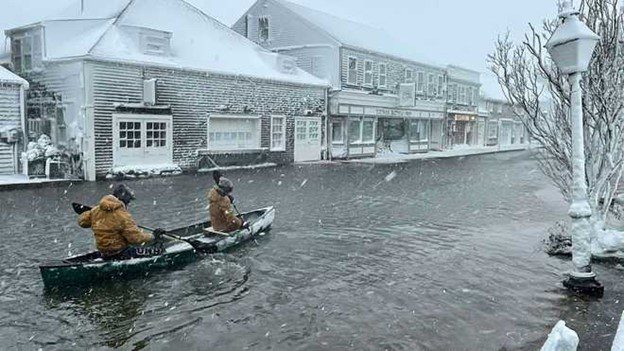Wang, O., T. Lee, C. G. Piecuch, I. Fukumori, I. Fenty, T. Frederikse, D. Menemenlis, R. M. Ponte, and H. Zhang, 2022. Local and Remote Forcing of Interannual Sea-Level Variability at Nantucket Island, Journal of Geophysical Research Oceans, 127(6), e2021JC018275, https://doi.org/10.1029/2021JC018275

This photo shows two people canoeing down a flooded road on the Massachusetts island of Nantucket during a powerful nor’easter on Jan. 29, 2022. Photograph courtesy of WCVB (https://www.wcvb.com/article/nantucket-massachusetts-nor-easter-update-january-29-2022/38932572)
The change in the rate of sea-level rise (SLR) in the northeast coast of the United States in the past few decades was 3–4 times higher than that of the global-mean SLR. The magnitude of interannual sea-level variation in this region is even larger than the long-term change over the last few decades. The causes of interannual sea-level variation there are not well understood, limiting the knowledge of sea-level predictability. This study identifies the causality of interannual variations of sea level near Nantucket Island with wind and buoyancy forcing. The latter is the combination of air-sea heat and freshwater fluxes. These forcings together affect sea level. We employ a method to separate the contributions of wind and buoyancy forcings, both near and away from Nantucket, on Nantucket sea level. Wind contribution is primarily near-local, from regions northeast of Nantucket along the New England shelf. Local and remote buoyancy forcing contributions are overall smaller than wind contributions, but can be comparable to wind contributions in some years. In particular, buoyancy forcing from the subpolar North Atlantic can affect Nantucket sea level a few years later, providing a source of predictability for Nantucket sea level.
This research was funded by the National Aeronautics and Space Administration (award 80NSSC20K1241, 80NM0018D0004) and published in the Journal of Geophysical Research Oceans.
